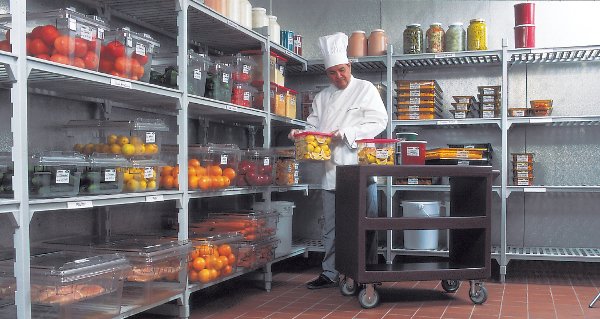As anyone would say and everyone would agree, the food industry is the most important industry for every economy. As food is the ultimate energy source for all humankind and even animals, we must not forget how important is the food inventory management. Since every item you pick from the supermarket or meal you consume at a restaurant must be fresh, the food industry needs to manage its inventory with the utmost attention. Inventory not only decides whether the available item is fresh, but it also takes care of various aspects of the food business such as available stock, and lesser food waste, and optimizes operational efficiency.
In this article, we will understand the concept of food inventory management, its benefits, and the best practices in restaurants.
What is Food Inventory Management?
Food inventory management holds the utmost importance in the restaurant business. As this sector comprises perishable goods, fluctuating demand, and strict regulatory requirements, it becomes paramount to manage food assets. Food inventory management involves systematic tracking and managing the food stock quantities. The processes start from ordering raw materials, their storage, tracking, and managing stock levels throughout its cycle.
Inventory tracking software is a helpful tool widely used for food inventory management as it takes care of all the processes in a centralized system. Efficient management of food assets helps to prevent stockouts or overstock ensuring that food products are always available in the restaurant when needed.
Benefits of Inventory Management for Restaurants:
Restaurants are more likely to succeed long-term if they practice efficient inventory management. Let’s dig deeper into the benefits of food inventory management in restaurants.
- Less Food Wastage:
About 10% of food gets wasted purchased by the restaurants even before reaching the consumer. Without the proper knowledge of their stock, restaurants buy too much food at a time which ends up wasting before being served at the table. With effective food inventory management, such disasters can be avoided.
- Optimized Cost:
Due to the loss of food through spoilage and wastage, the cost of an item has doubled as the restaurant will have to buy it again. The food cost can be lowered if the spoiling is avoided with the help of inventory management. - Effective Vendor Management:
As restaurants are efficiently able to keep track of their food and purchases, vendor management becomes easier. Vendors are paid on time and pre-orders to the vendors help in the availability of goods at all times. - Upholding Safety Standards and Food Quality:
The inventory management system keeps a good look at the expiration dates of perishable items. It also helps in maintaining quality standards by regulating correct storage conditions. This way restaurants can keep all their ingredients fresh and maintain high food quality and standards for the consumers. - More Focus on Restaurant Operations:
Due to the implementation of inventory management, less time is spent on manual inventory tasks. Restaurant workers can now spend more time on customer service and bringing in better ideas for the success of the business.
How to Implement Food Inventory Management in Your Restaurant?

Implementing a food inventory management system might seem like an overwhelming task but once you have streamlined the process with the right tools and strategy, you will enjoy its perks to the maximum in your restaurant. This involves a series of steps that will lead to successful inventory management leading to optimal food quality, smooth operations, and reduced costs. There are six steps involved in this process:
- Perform Initial Inventory Count:
Begin by undertaking a comprehensive audit of all food items in your restaurant. This is the initial data you require to start your inventory management system. - Categorize your Inventory:
Arrange your food items into meaningful categories like perishables, non-perishable or dry goods. Make sure that each item is kept in its assigned category in its right location and under proper conditions to maintain its quality. - Implement a Tracking System:
As there are numerous tracking tools available with numerous benefits, it’s hard to choose which one to implement in your business. However, keeping in mind your business’s needs and looking for similar features in a tracking system will be helpful for you to make up your mind. - Keep Regular Inventory Counts and Ordering Procedures:
Run inventory counts weekly or monthly to maintain accurate inventory data and identify potential threats earlier. Also, form a standard procedure for ordering and receiving restaurant food items, including quality checks, shipment verification, and timely inventory record updates. - Use Data for Menu Planning:
You can use your inventory data for menu planning and demand forecasting. This is to ensure that you are purchasing the right ingredients to meet customer demand. - Train your Staff Well:
Once you have implemented the system your staff must be well-trained about the system to enjoy its benefits. Teach them the importance of proper inventory management and educate them about the new tools you have implemented.
Inventory Management for Restaurants Best Practices:
We have learned the benefits of implementing inventory management in your restaurant, let’s explore some of the best practices restaurant owners have adopted for success:
- Organize your Inventory:
Put labels on your shelves and organize every item on those shelves according to their categories. This helps staff to find these items quickly when required. It also makes restocking goods easier. Keep a close spot for most-used goods to be able to readily find them. - Keep Stock Levels Low:
With the help of an inventory management system, you can assess how much a particular food item is required so buy only the required stock of that item. This goes for all inventory. The reason is to avoid waste and the item will not take the unnecessary space in your storage which could be used for other equipment. - Track All Inventory:
Track all items that your restaurant uses such as steaks, potatoes, staff uniforms, and napkins. Depending on their use and purchase, you can track these items accordingly. For instance, everyday ingredients for a particular menu should be tracked daily or weekly but the staff uniform can be tracked yearly. - Employee Accountability:
Assign this task to trained employees who can track all food and beverages that go out of the restaurant and the money made through them. Help those employees to become a part of the solution and understand all processes that are in place for tracking inventory. - Automate Reordering:
It is best to let your inventory management system automatically reorder stock when supplies are about to end. This way you will never lack any item during the food preparation.
Need for Digitization in the Food Industry
The food industry is vast and consists of numerous backend processes to allow consumers to enjoy a soulful bite of their favorite dishes. To meet the ever-increasing customer demands for quality products, the food industry needs to digitize its operations. Bringing in technology for smooth operations allows stakeholders to end the hectic manual processes, increase efficiency, and reduce costs. This way the food industry will flourish and meet the high demands of its customers.
Featured image from Recipal.


